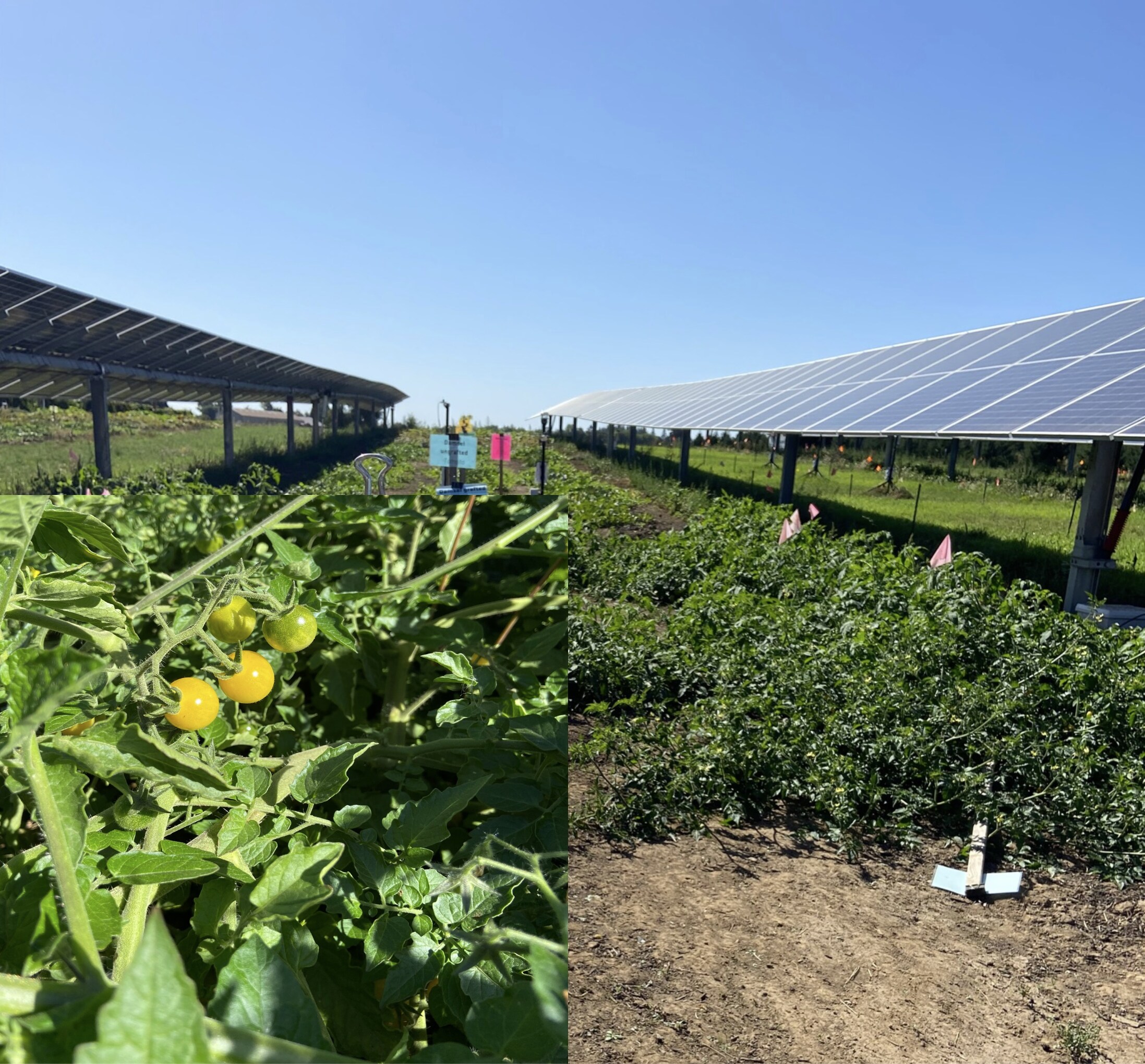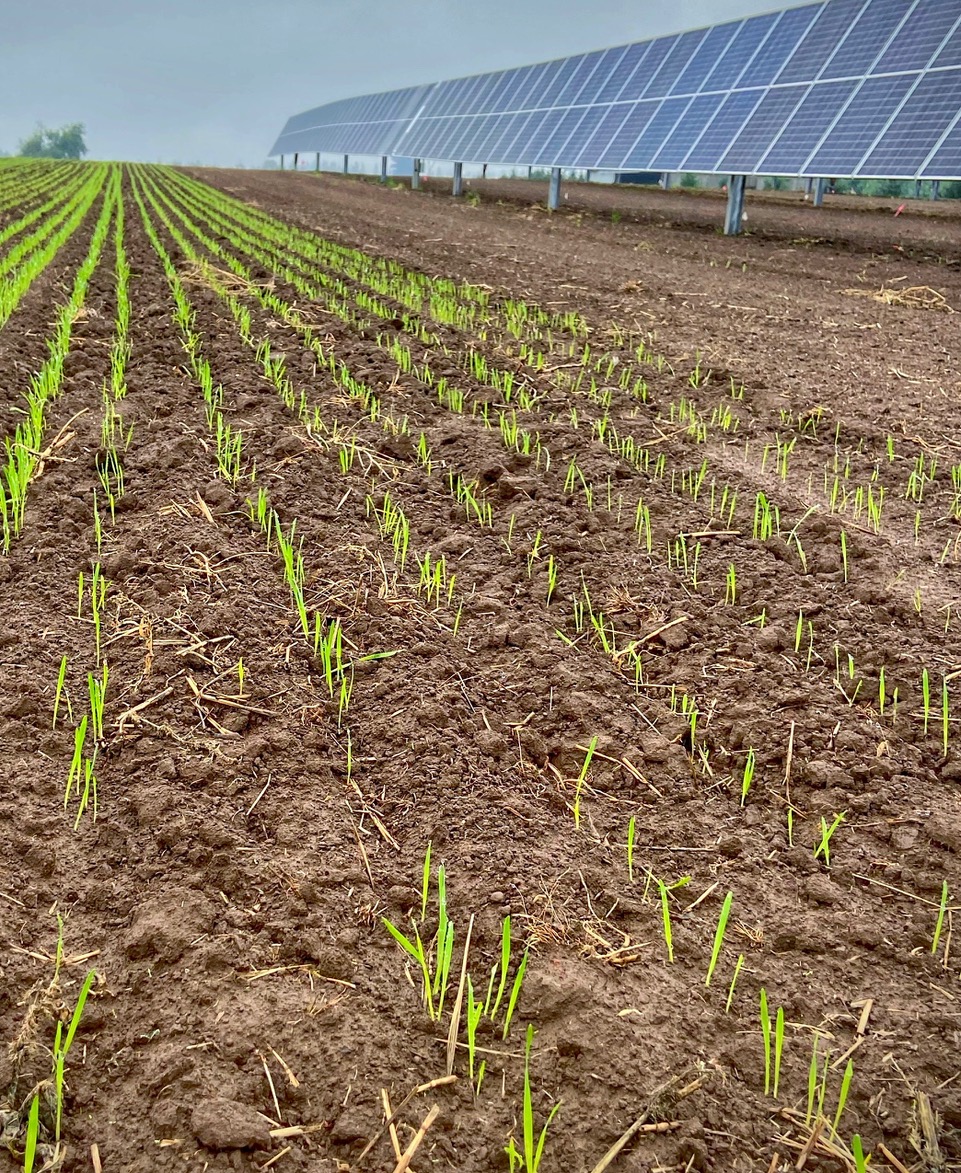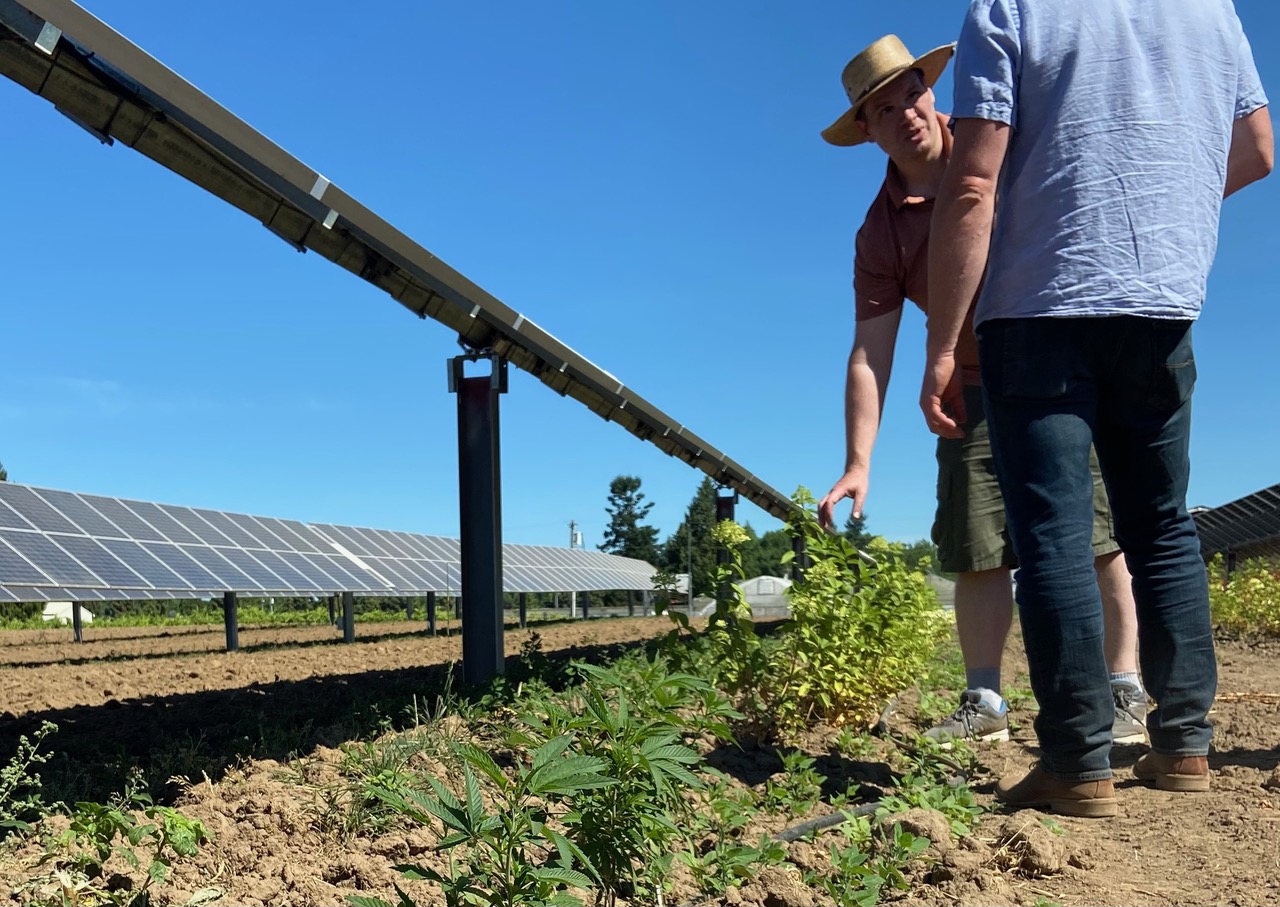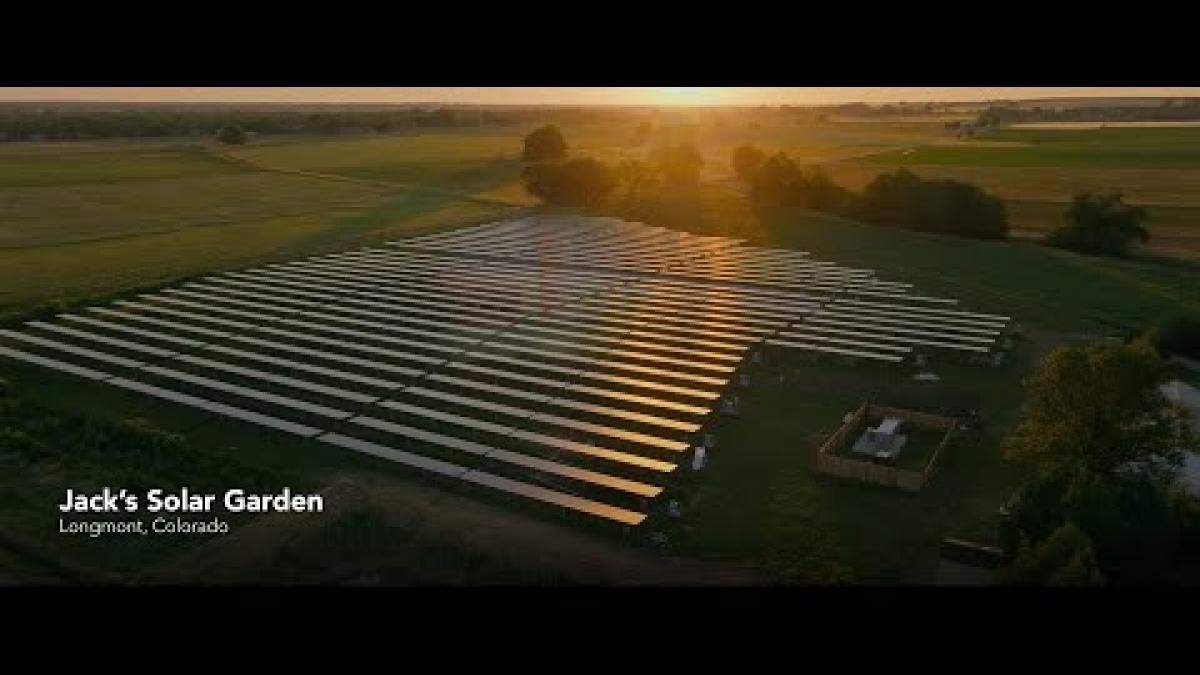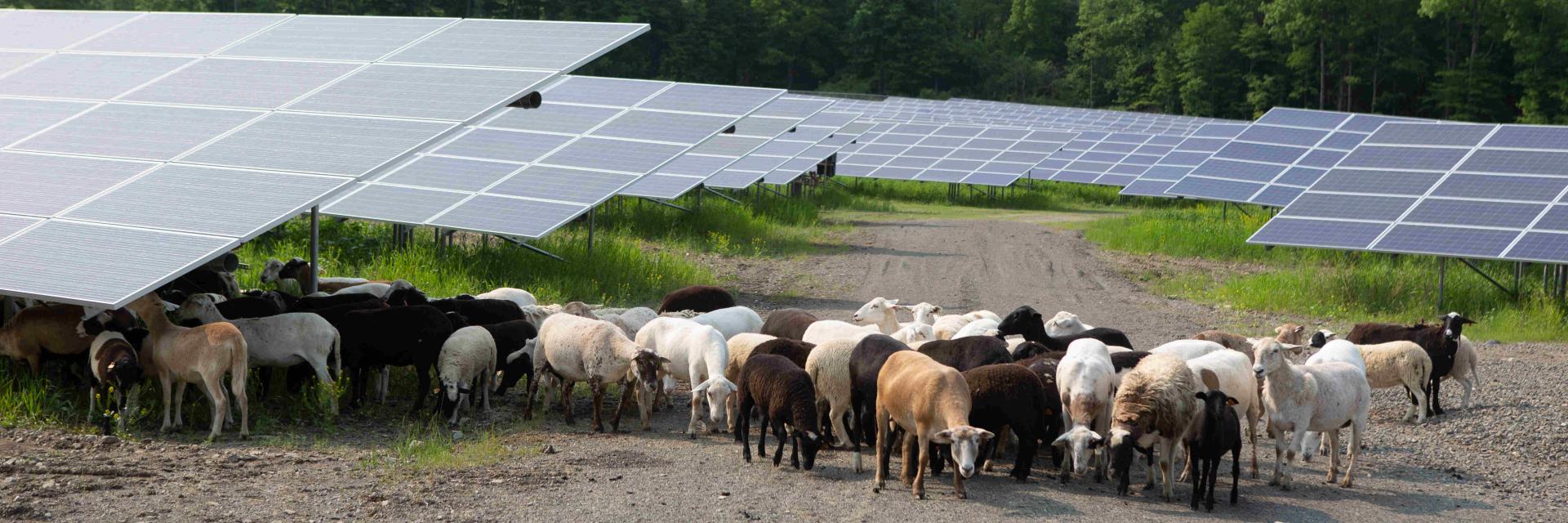
Sheep grazing and using solar panels for shade on an agrivoltaic farm.
Courtesy of: American Solar Grazing Association, solargrazing.orgAgrivoltaics
Optimize the use of land suitable for both agriculture and solar photovoltaic power generation by integrating them simultaneously.
Agrivoltaics, also known as dual-use solar, integrates solar photovoltaic power (PV) generation and agriculture on the same parcel of land, often by growing crops beneath solar panels. The concept was developed in Europe, where open space is at a premium. Land that is optimal for agriculture is often also optimal for solar arrays, which can lead to competition that slows or halts renewable energy development. Agrivoltaics is a way to do both. It is estimated that if 1 percent of farmland was used for agrivoltaics in the United States, national renewable energy targets could be met. The same goes for Europe. The country could reach net zero if implemented on four percent of Canadian farms. The benefits of agrivoltaics include increasing land use efficiency, making solar installations more amenable to local communities, and providing a cooler environment for the solar panels, which increases their efficiency. The panels can also provide shade for plants and animals, which helps them handle rising temperatures due to global warming. Taken together, agrivoltaics is emerging as an innovative solution.
Action Items
Individuals
Learn about agrivoltaics and its benefits. By offering multiple benefits from the same piece of land, agrivoltaics helps us shift from having to choose between solar energy production and agriculture to a more synergistic understanding of land use. By helping to keep local farms alive, agrivoltaics can play a part in maintaining the viability of local economies. Global demand for food is expected to increase by 35 to 56 percent by 2050, while global energy demand is expected to increase by 50 percent in the same period of time. By combining the production of food and energy efficiently, agrivoltaics will be important in meeting both needs. It can lead to ancillary benefits such as increased efficiency in water usage and increased carbon dioxide uptake. Growing crops beneath solar panels have also been shown to increase the efficiency of the panels, especially when combined with smart agrivoltaic systems managed by AI software. The three basic types of agrivoltaic systems are:
- Solar panels next to or above crops or native plants. In agricultural use, this system either alternates between solar panels and crops, or uses the panels to create shade in which to grow shade-tolerant crops. Another major use of agrivoltaic systems is to utilize the space to grow native pollinator plants, helping to mitigate the continuing loss of pollinator habitat.
- Solar panels above land that animals graze. Some ranchers add solar arrays to their pastures to diversify revenue. There are also a growing number of sheep grazers who are contracted out to maintain native pastureland beneath commercial solar arrays. As temperatures rise, solar panels can provide necessary shade for animals and keep them cool and hydrated. This is similar to the role trees play for livestock in silvopasture systems (see Silvopasture Nexus). Contracting grazers to maintain native pastureland beneath commercial solar arrays has the added benefit of reducing the need for herbicides and lawn mowing.
- Solar greenhouses. Adding solar panels to a greenhouse can increase energy efficiency on the farm and reduce costs, depending on the type of panels used. With the advent of transparent and semi-transparent solar panels, greenhouses are becoming a major source of on-farm solar energy production. This innovative project in Europe uses a crop-responsive tracking system that adjusts panels to increase yields.
Understand the potential for agrivoltaics in your community. Community Solar Farms is part of a movement to decentralize power distribution and empower local communities. One U.S. study found that more than 80 percent of people would be more likely to support solar arrays in their communities if they were integrated with agriculture. In the United States, the Inflation Reduction Act has earmarked $7 billion in funding and assistance for small-scale community solar projects.
Connect with other advocates for agrivoltaics and speak out in your community. Find other people who are interested and knowledgeable in the field of agrivoltaics at places such as the Solar Farm Summit in order to strategize effective ways of bringing this solution to your local farms and communities. Advocacy groups have sprouted up in the U.S., including Solar United Neighbors, which assists individuals and communities in activating solar co-ops and small-scale community solar solutions (see Solar Nexus).
Groups
Farmers, Ranchers, and Other Landowners
Understand the benefits of agrivoltaics for your farm or ranch. Agrivoltaics offers a diversification strategy to protect against the difficulties of more extreme weather affecting production on the farm. Agrivoltaics also addresses the problems of higher operating costs and increased competition for land.
Implement agrivoltaics into your farm or ranch. Implementing agrivoltaic solutions can be as simple as putting a few solar panels on your farm or ranch in order to use the space to meet your own energy needs, such as power for irrigation, electricity, and electric tractors and equipment.
- The U.S. Office of Energy Efficiency and Renewable Energy has put out this guide for farmers who want to incorporate agrivoltaics on their farms.
- Many solar companies, such as Blue Wave in the U.S. and Sun’Agri in Europe, focus on helping farmers implement agrivoltaics. Since it is a win-win for both the farmer and the solar company, many solar installers will be eager to help in the process.
Diversify revenue streams. Moving toward a global emphasis on sustainable agriculture will require that the economic needs of small farmers be consistently met. As recognized by this bipartisan bill in the U.S. Senate, utilizing agrivoltaics to diversify revenue streams will help ensure a future for farms and ranches in a changing climate. Here are five examples, ranging from grazing to viticulture, that exemplify the benefits of agrivoltaics to diversify revenue streams on the farm.
- Japan, an early adopter and global leader in small-scale agrivoltaic solutions, is optimizing the use of limited agricultural land with sustainable practices that benefit farmers.
- In Kenya, agrivoltaics are helping rural farmers increase their incomes while providing their communities with much-needed energy. This can be a key development in helping rural communities in Africa become more self-sufficient.
Optimize land use. Agrivoltaics not only can provide economic benefits to farmers but can help them shift agriculture to a more sustainable and ecologically friendly institution.
- Founded by sheep farmers who became solar grazers, the American Solar Grazing Association works to facilitate research, outline best practices, and connect sheep farmers and solar array owners who need vegetation management services.
- Vineyards, which are water-intensive, can benefit from agrivoltaic installations. This research project in southern France found a 12–34 percent decrease in water usage, while vines that would normally be stressed by sunlight in a drought continued to grow in the shade of the solar panels.
- Many agrivoltaic projects utilize the space around the solar arrays to grow wildflower and pollinator meadows that benefit the ecosystem and nearby farms. Pollinator agrivoltaics are playing an increasingly large role in solar farm projects and land reclamation projects.
- Responsible and careful use of water is a core issue for any farm, and research has shown that agrivoltaic installation reduces water usage by significantly reducing soil water evaporation. One study showed an increase in crop yield with a reduction in water usage.
Take advantage of government incentives for installing solar on your land. Governments across the world have committed to helping farmers and landholders install agrivoltaic systems. Australia and the U.S. have funding and financing opportunities, Germany and France have instituted successful incentive structures, and Italy and Japan both offer rebates and grants for agrivoltaic projects. The $1 billion REAP program in the U.S. focuses on funding and rebates for ranchers and farmers who want to install agrivoltaic systems. Reach out to your local or national government agencies for help.
Solar Companies
Dedicate a portion of your business to working with agrivoltaics. The agrivoltaic market is growing every year and is estimated to be valued at $9.3 billion by 2031. By engaging in agrivoltaic projects, companies can actively help protect farmland and ecosystems while furthering the production of renewable energy. While large companies can include agrivoltaic projects in their portfolio, there is market space for small companies, such as this one in the U.S., which can focus solely on agrivoltaics.
- At Silicon Ranch, they are focusing on regenerative energy in an effort to make solar energy not just about producing energy, but about healing ecosystems and improving land stewardship.
- Blue Wave Solar has developed over thirty dual-use projects, which include energy production, storage, social impact, and environmental restoration.
- Based in France, Akuo Energy implements agrivoltaic projects around the world, including this one in New Caledonia.
- BayWa, in Germany, is a leader in agrivoltaic installation and management, including these pilot projects that combine solar and fruit production and those that focus on sheep grazing.
- The French company Sun’Agri focuses on the use of agrivoltaics to help farmers mitigate the negative effects of climate change on their farms.
Governance
Fund Research and Development. Governments can continue to fund research and provide guidelines based on their findings, such as this study by the New York Power Authority and this one in Denmark. Some other research projects include:
- InSPIRE, funded by the U.S. Department of Energy, looks at long-term ecosystem impacts and economic viability.
- The French Ministry of Energy Transition is funding four agrovoltaic projects through the company Iberdrola, with a total output of 12 Mw.
- Colorado became the first state in the U.S. to fund agrivoltaic projects with bipartisan support.
- The U.S. Department of Energy has recently announced $8 million in funding for research and development, which is being used by over six different projects, including this one at the University of Alaska, focusing on small community-based agrivoltaic systems.
- This government-led agrivoltaic project in New Zealand will be the first utility-scale solar project in the country.
Support education and awareness campaigns. Governments can create national awareness campaigns and generate resources to help farmers and agrivoltaic supporters, such as this guide from the Australian government. Governments can use campaigns that raise public awareness about the importance of pollinators for healthy farms and ecosystems to also raise awareness of the role of agrivoltaics in keeping pollinator populations healthy.
- Australian Pollinator Week can be replicated at all scales of governance. Declare a day or a week for pollinator-related events and workshops— such as photo contests, educational workshops, or outdoor outings— while highlighting organizations doing amazing work in your area.
- The EU Pollinators Initiative, adopted by the European Commission in 2018, was created to address the decline of wild pollinating insects. As of 2020, over thirty actions have been implemented, one of which is the Pollinator Park, an interactive digital tool to raise awareness about declines and mobilize action. See Pollinators Nexus.
Key Players
Organizations
American Solar Grazing Association (U.S.) supports and promotes solar grazing by identifying best practices, providing educational materials, and facilitating connections between solar developers and farmers. They also offer ASGA Certification for solar grazing training.
Agrivoltaics Europe Conference (E.U) discusses agrivoltaics as an approach, solution, and business model for farmers as well as innovations, benefits, limitations, and opportunities. Sign up to learn about future conferences.
Solar Energy International (Colorado, U.S.) empowers students, alumni, and partners to expand a diverse, inclusive, well-trained, and educated solar workforce and spread the knowledge of how to safely deploy industry-leading technology, including a focus on agrivoltaics.
SCAPES Agrivoltaic Project (U.S.) is an interdisciplinary team of agriculture, economics, geography, biology, psychology, and engineering researchers. With sites in Illinois, Arizona, and Colorado, our work aims to boost renewable energy and the resiliency of food production—at the same time.
International Solar Alliance (India) is an action-oriented, member-driven, collaborative platform for increased deployment of solar energy technologies, including agrivoltaics, as a means for bringing energy access, ensuring energy security, and driving energy transition in its member countries.
The National Solar Federation of India provides pioneering research through its publications, explores the country's Agrivoltaic projects through its interactive map, and lists upcoming agri-PV events from around the world.
The Solar Farm Summit (U.S.) is a solar energy, land use, and agrivoltaics conference and expo focused on ground-mounted solar development and dual-use projects co-locating solar power and agricultural production or advanced conservation practices, including pollinator habitat, as well as the redevelopment of marginal and brownfield land.
Solar United Neighbors (U.S.) are organizers, educators, communicators, and policy and technology "nerds," dedicated to building an energy system that works, including agrivoltaics.
Agrivoltaics Canada is a Canadian not-for-profit organization dedicated to championing and integrating farmer-centric advancements in the realm of agrivoltaics, also described as farm-first solar, agri-solar and dual-use solar.
Farms
Solar Harvest Farm (U.S.) is the first field-scale research station specifically designed to allow researchers to study the impact of solar panels on soil health, water use, and plant physiology and yields.
Jack's Solar Garden (Colorado, U.S.) is a family-owned social enterprise that is doing more with our family farm for the betterment of our community, including valuable research into the public sphere on co-locating solar panels with agriculture (agrivoltaics).
Teslaagro (Zhytomyr, Ukraine) is the sole Ukrainian agrivoltaic enterprise where they grow blueberries and raise sheep.
Sprout City Farms (U.S.) collaborates with communities to pursue food justice by cultivating innovative, restorative, and educational farms, including Jack's Solar Garden.
Cannon Valley Graziers (U.S.) specializes in adaptive grazing and targeted vegetation management, working closely with our clients to help them meet their goals in prairie, forest, and agrivoltaic settings.
Companies
Silicon Ranch (U.S.) is a full-service solar and carbon solutions company committed to boosting economies, strengthening communities, and restoring healthy air, water, and soil.
Akuo Energy (France) invents and co-constructs new models of renewable energy production, including agrivoltaics, for the sustainable development of territories.
BayWa (Europe) provides their clients with carbon-free energy solutions including agrivoltaics.
Sun’Agri (France) has developed proprietary software called AV Studio©, which enables the creation of control algorithms that allow the photovoltaic panels to be adjusted in real time to optimize plant growth.
Heliene (Europe) offers specially designed BiPV solar glass modules for greenhouses, and their greenhouse-integrated PV (GiPV) modules offer a sustainable alternative with no additional racking or support, allowing greenhouses to run on 100% renewable energy.
Midwest Agrivoltaic Systems (U.S.) specializes in solar energy systems designed specifically for agriculture commonly found in the Midwest.
TSE Energy (France) works in service to the energy and agricultural transitions, developing qualitative solar solutions that benefit farmers and rural communities.
Learn
Watch
Agrivoltaics at Jack's Solar Garden by Byron Kominek @ Jack's Solar Garden (4 mins.)
NREL’s Agrivoltaic Research by National Renewable Energy Laboratory - NREL( 2 mins.)
How Solar Panels Are Changing Agriculture - Agrivoltaics Revisited by Undecided with Matt Ferrell (13 mins.)
Agrivoltaics: An Economic Lifeline for American Farmers? by Just Have a Think (15 mins.)
How Agrivoltaic Farming Can Help Solve Our Food and Energy Crisis by Down On The Farm (9 mins.)
Why We Should Be Putting Solar Panels on Our Fields and Lakes by DW Planet A (15 mins.)
Read
Solar Energy Advancements in Agriculture and Food Production Systems edited by Shiva Gorjian and Elia Campana / Elsevier
Agrivoltaics: A Sustainable Integration of Solar Energy and Agriculture by Guiseppe Saturno
Listen
Sheep + Solar, a Love Story by How to Save a Planet (31 min.)
A Rosy Future for Agrivoltaics by Factor This! Podcast (50 min.)
Agrivoltaics: The Future of Farming & Renewable Energy by Rewildology (13 min.)
Share this page


